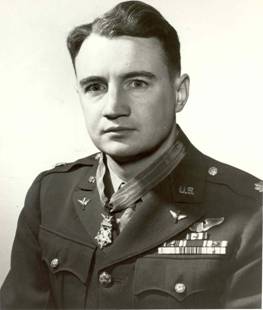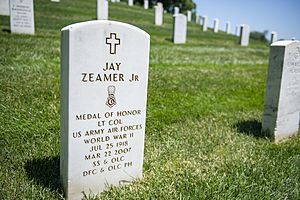Jay Zeamer Jr. facts for kids
Quick facts for kids
Jay Zeamer Jr.
|
|
|---|---|

Lt. Col. Jay Zeamer Jr.
|
|
| Born | July 25, 1918 Carlisle, Pennsylvania, US |
| Died | March 22, 2007 (aged 88) Boothbay Harbor, Maine, US |
| Place of burial | |
| Allegiance | |
| Service/ |
|
| Years of service | 1939–1945 |
| Rank | |
| Unit | 65th Bomb Sqdn, 43rd Bomb Grp Fifth Air Force |
| Battles/wars | World War II |
| Awards |
|
Jay Zeamer Jr. (born July 25, 1918 – died March 22, 2007) was a brave pilot for the U.S. Army Air Forces during World War II. He flew dangerous missions in the South Pacific. Jay Zeamer received the Medal of Honor, the highest award for bravery, for an amazing flight on June 16, 1943. After the war, he became an engineer in the aerospace field.
Contents
Jay Zeamer's Early Life
Jay Zeamer Jr. was born in Carlisle, Pennsylvania. He grew up in Orange, New Jersey. As a child, he spent many summers in Boothbay Harbor, Maine. He loved rowing a boat he made himself in the harbor.
Jay became an Eagle Scout when he was just 14 years old. This is a very high achievement in scouting! He is one of only nine known Eagle Scouts who also received the Medal of Honor.
After high school, Jay went to Culver Military Academy in Culver, Indiana. He was excellent at shooting and was part of the Color Guard. He then went to the Massachusetts Institute of Technology (M.I.T.). In 1939, when he turned 21, he joined the Army Reserve as a second lieutenant.
Jay was interested in flying from a young age. He joined the M.I.T. flying club in 1938. Within a year, he had his pilot's license. In 1939, he applied for the Army Air Corps flight training program. He was accepted and started training after graduating from M.I.T. in 1940. He studied civil engineering. Jay was a leader in his flight class, earning the title of Captain of Cadets.
Military Service in World War II
In March 1941, Jay became a pilot in the U.S. Army Air Corps. He was first assigned to the 96th Bombardment Squadron. Later, he joined the 63rd Bombardment Squadron of the 43rd Bombardment Group. Here, he met Joseph Sarnoski, who would become his bombardier.
Jay was sent to Australia in March 1942. He flew his first combat mission as a co-pilot on April 6, 1942. He was promoted to first lieutenant that same month.
Flying the B-17 Flying Fortress
In August 1942, Jay transferred to the 43rd Bombardment Group. This group flew the new Boeing B-17 Flying Fortress planes. He joined the 403rd Bombardment Squadron in Torrens Creek, Australia. Even though he had no experience flying the B-17, he quickly gained combat experience. On November 20, he flew his first mission as the main pilot. It was a photo mission over Rabaul, New Britain. He earned the Silver Star for this mission.
Around late 1942, Jay started putting together his own crew. They called themselves the "Eager Beavers" because Jay always volunteered for missions. In January 1943, his crew helped sink a ship at Rabaul. This earned them Air Medals.
In March 1943, Jay transferred to the 65th Bombardment Squadron in Port Moresby, New Guinea. He was promoted to captain in April. On April 12, the Eager Beavers flew another mission to Rabaul. Jay received another Silver Star for this flight.
In May 1943, Jay became the squadron executive officer. He began to improve a B-17E bomber, #41-2666. This plane had special cameras for mapping. Jay and his crew replaced the engines and made the plane lighter. They also added many extra guns, including 16 guns in total! This plane became known as "'666" or "Old 666."
The Medal of Honor Mission
The President of the United States, on behalf of Congress, is pleased to award the Medal of Honor to:
ZEAMER, JAY JR. (Air Mission)
Rank and organization: Major, U.S. Army Air Corps. Place and date: Over Buka area, Solomon Islands, June 16, 1943.
What happened:
- On June 16, 1943, Major Zeamer (then a Captain) volunteered to pilot a bomber. The mission was to take important photos of the heavily defended area near Buka, Solomon Islands. While taking pictures of the Buka airfield, his crew saw about 20 enemy fighter planes. Many of them were taking off. Even though it was very dangerous, Major Zeamer continued his photo run. The enemy planes attacked. Major Zeamer was shot in both arms and legs, and one leg was broken. Despite his injuries, he flew the damaged plane so well that his gunners could fight off the enemy for 40 minutes. His crew destroyed at least 5 enemy planes, and Major Zeamer shot down one himself. He was losing a lot of blood but refused medical help until the enemy planes left. He then let another pilot take the controls, but he kept giving orders even when he passed out. He guided the flight to a base 580 miles away. In this brave action, Major Zeamer, with great skill and courage, completed a very important mission.
In April 1943, Jay and his crew were asked to fly a solo photo-mapping mission. It was a 1,200-mile round trip over the western coast of Bougainville. This mission was very important for future plans to invade the island. The mapping runs needed the plane to fly straight and level for up to 22 minutes deep in enemy territory. This made the mission very risky.
On June 16, 1943, the crew headed for Bougainville. They were told to also take photos of the Japanese airstrip on Buka. Jay had refused this idea twice before because it was too dangerous. He knew it would almost certainly lead to an attack by enemy fighters.
But the crew voted to do the Buka photo mission. As they flew over Buka, photos showed 21 Japanese fighter planes taking off to attack them. "Old 666" was attacked by eight Japanese Zero fighters.
During the attack, bombardier Sarnoski was badly wounded. He was blown from his position by a 20 mm cannon shell. But he bravely struggled back to his gun to fight off another Zero. Jay Zeamer was also hit. Four 20 mm shells destroyed his instrument panel. His left leg was broken in two places, and he had a large hole in his thigh. He was also hit by shrapnel in both arms and his right leg. Three other crew members were wounded.
To escape, Jay dived the plane quickly from 25,000 feet to about 10,000 feet. The Japanese fighters followed. For 40 minutes, they kept attacking the front of the B-17. Even with his injuries, Jay skillfully turned the plane into the oncoming fighters. This made the Zeros miss their shots and expose themselves to the B-17's rear guns. Eventually, all the Zeros left, either damaged or out of fuel.
After the fight, the B-17's oxygen and hydraulic systems were destroyed. All of Jay's flight instruments were gone. Jay was too wounded to move, but he refused to give up command. He guided the top turret gunner, who took over as co-pilot. The plane made an emergency landing at an Allied airstrip in Dobodura, New Guinea. The plane had no working brakes or flaps, but the co-pilot managed to land it safely.
One crew member, Sarnoski, was killed. Four others, including Jay, were wounded. Jay was first thought to be dead from blood loss, but he was treated. He was then taken back to Port Moresby.
General George Kenney recommended Jay for the Medal of Honor. Jay received the award from General Henry H. Arnold on January 16, 1944. Sarnoski was also awarded the Medal of Honor for his bravery. This was only the third time in U.S. history that two members of the same crew received the Medal of Honor for one mission. All other members of Jay's crew received the Distinguished Service Cross. This mission remains the most highly decorated single air mission in American history.
Promotions and Retirement
Jay was promoted to major on July 8, 1943. He became a lieutenant colonel in April 1944. He spent 15 months recovering from his injuries. He regained most of the use of his left leg. On January 18, 1945, Jay retired from the U.S. Army Air Forces due to his injuries.
Later Life and Legacy
After the war, Jay returned to M.I.T. and earned a master's degree in aeronautical engineering in 1946. He then worked for several aerospace companies, including Pratt & Whitney and Raytheon.
In 1968, Jay moved to Boothbay Harbor, Maine. He enjoyed rowing in the harbor, just like he did when he was a child. He retired in 1975.
Jay married Barbara in 1949, and they had five daughters. Barbara said that Jay rarely talked about his wartime experiences or the medal. He felt terrible about his bombardier, Sarnoski, being killed.
Jay Zeamer Jr. died at age 88. He was the last living Medal of Honor recipient from the Army Air Forces at the time of his death. He was buried at Arlington National Cemetery in Arlington, Virginia. The governor of Maine ordered flags to be flown at half-staff on the day of his funeral.
Awards and Honors
Jay Zeamer received many awards for his bravery and service:
 Army Air Forces Pilot Badge
Army Air Forces Pilot Badge Medal of Honor
Medal of Honor Silver Star (with one oak leaf cluster)
Silver Star (with one oak leaf cluster) Distinguished Flying Cross (with one oak leaf cluster)
Distinguished Flying Cross (with one oak leaf cluster) Purple Heart
Purple Heart Air Medal (with one oak leaf cluster)
Air Medal (with one oak leaf cluster) American Defense Service Medal
American Defense Service Medal American Campaign Medal (with one service star)
American Campaign Medal (with one service star) Asiatic-Pacific Campaign Medal (with five campaign stars)
Asiatic-Pacific Campaign Medal (with five campaign stars) World War II Victory Medal
World War II Victory Medal Army Presidential Unit Citation
Army Presidential Unit Citation
Remembering Jay Zeamer
Jay Zeamer's Medal of Honor mission has been featured on The History Channel. It was also written about in a magazine article called "Mission Over Buka" by Martin Caidin.
There is a "Lt Col Jay Zeamer Squadron" in the Arnold Air Society at the Massachusetts Institute of Technology.
The headquarters building of the 43d Airlift Wing at Pope Air Force Base was named in Jay Zeamer's honor in 2008.
In 2011, Jay Zeamer was chosen as the "class exemplar" for the Class of 2014 at the United States Air Force Academy. His name is now worn on the athletic jackets of that class.



